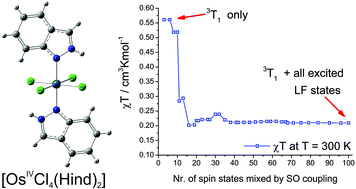Towards understanding the magnetism of Os(iv) complexes: an ab initio insight†
Abstract
The magnetism of a recently synthesized trans-[OsIVCl4(κN1-Hind)2] complex (5d4-system), where Hind = 2H-indazole, was studied experimentally and theoretically. Relativistic CASSCF/CASPT2 calculations for this and model [OsIVCl6]2− complexes were employed to understand the nature of the low-lying multiplets. It is found that despite strong metal–ligand covalency they are basically characterized by the total angular pseudo-momentum ![[J with combining tilde]](https://www.rsc.org/images/entities/i_char_004a_0303.gif) originating from the spin–orbit coupling of the ground-state spin S = 1 with the orbital pseudo-momentum
originating from the spin–orbit coupling of the ground-state spin S = 1 with the orbital pseudo-momentum ![[L with combining tilde]](https://www.rsc.org/images/entities/i_char_004c_0303.gif) = 1 of the OsIV ion. The strong spin–orbit interaction also preserves the dominant
= 1 of the OsIV ion. The strong spin–orbit interaction also preserves the dominant ![[J with combining tilde]](https://www.rsc.org/images/entities/i_char_004a_0303.gif) = 0 character of the non-magnetic ground state in the trans-[OsIVCl4(κN1-Hind)2] complex despite significant deviation of the ligand environment of OsIV from octahedral symmetry. At the same time the spin–orbit admixture of all multiplets arising from the t2g4 strong-field electronic configuration is indispensable for the correct description of magnetic properties of OsIV complexes. Moreover, based on ab initio calculations, we argue that the charge-transfer states play an important role in the magnetism of the present and probably other 5d complexes, a situation never encountered for 3d and 4f compounds.
= 0 character of the non-magnetic ground state in the trans-[OsIVCl4(κN1-Hind)2] complex despite significant deviation of the ligand environment of OsIV from octahedral symmetry. At the same time the spin–orbit admixture of all multiplets arising from the t2g4 strong-field electronic configuration is indispensable for the correct description of magnetic properties of OsIV complexes. Moreover, based on ab initio calculations, we argue that the charge-transfer states play an important role in the magnetism of the present and probably other 5d complexes, a situation never encountered for 3d and 4f compounds.



 Please wait while we load your content...
Please wait while we load your content...